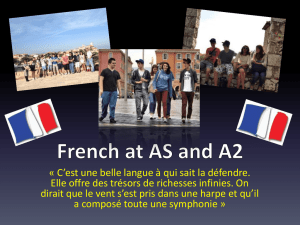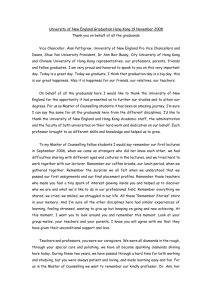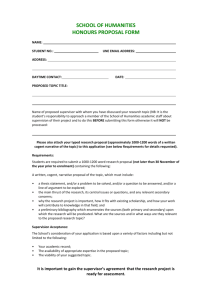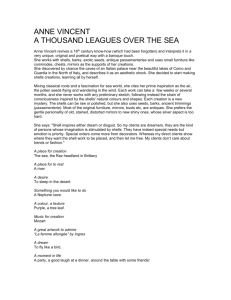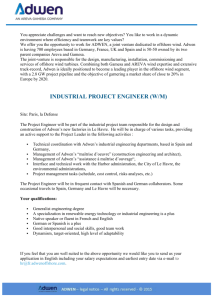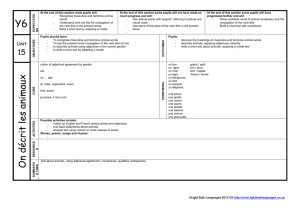flying in france - West London Aero Club
advertisement
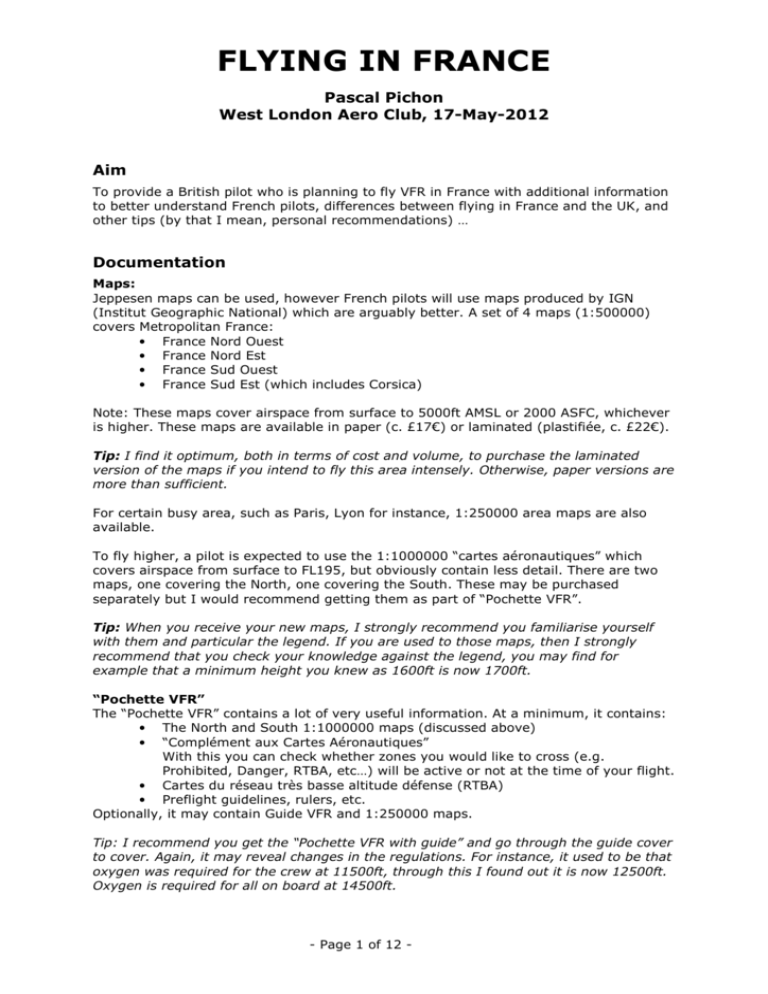
FLYING IN FRANCE Pascal Pichon West London Aero Club, 17-May-2012 Aim To provide a British pilot who is planning to fly VFR in France with additional information to better understand French pilots, differences between flying in France and the UK, and other tips (by that I mean, personal recommendations) … Documentation Maps: Jeppesen maps can be used, however French pilots will use maps produced by IGN (Institut Geographic National) which are arguably better. A set of 4 maps (1:500000) covers Metropolitan France: • France Nord Ouest • France Nord Est • France Sud Ouest • France Sud Est (which includes Corsica) Note: These maps cover airspace from surface to 5000ft AMSL or 2000 ASFC, whichever is higher. These maps are available in paper (c. £17€) or laminated (plastifiée, c. £22€). Tip: I find it optimum, both in terms of cost and volume, to purchase the laminated version of the maps if you intend to fly this area intensely. Otherwise, paper versions are more than sufficient. For certain busy area, such as Paris, Lyon for instance, 1:250000 area maps are also available. To fly higher, a pilot is expected to use the 1:1000000 “cartes aéronautiques” which covers airspace from surface to FL195, but obviously contain less detail. There are two maps, one covering the North, one covering the South. These may be purchased separately but I would recommend getting them as part of “Pochette VFR”. Tip: When you receive your new maps, I strongly recommend you familiarise yourself with them and particular the legend. If you are used to those maps, then I strongly recommend that you check your knowledge against the legend, you may find for example that a minimum height you knew as 1600ft is now 1700ft. “Pochette VFR” The “Pochette VFR” contains a lot of very useful information. At a minimum, it contains: • The North and South 1:1000000 maps (discussed above) • “Complément aux Cartes Aéronautiques” With this you can check whether zones you would like to cross (e.g. Prohibited, Danger, RTBA, etc…) will be active or not at the time of your flight. • Cartes du réseau très basse altitude défense (RTBA) • Preflight guidelines, rulers, etc. Optionally, it may contain Guide VFR and 1:250000 maps. Tip: I recommend you get the “Pochette VFR with guide” and go through the guide cover to cover. Again, it may reveal changes in the regulations. For instance, it used to be that oxygen was required for the crew at 11500ft, through this I found out it is now 12500ft. Oxygen is required for all on board at 14500ft. - Page 1 of 12 - The cost of “Pochette VFR with VFR Guide” is c. 25€. Obtaining the documentation The paper documentation can sometime be purchased in Airport but this can be unreliable (i.e. not stocking or out of stock for the maps you want). The most reliable way is to order them on line. They are several sources; here are two which I have used myself over the years. • http://www.sia.aviation-civile.gouv.fr/default.htm o I recommend this site if all you want are French charts. o In the “Boutique SIA” section click on “Cartes” o Click “Ajoutez au panier” for the item you wish to purchase o Make sure you select “zone Europe” at the bottom. o Click “Retour Boutique” to add another item to your “panier”/basket and so on. o Then click “Déjà client”/already a customer or “Nouveau client”/new customer to proceed with your order • http://www.boutique.aero/ o I recommend this site when you need more than just French charts. o Put your mouse pointer over “Je découvre la gamme et les rayons” o Take the pointer down to “Cartes aéronautiques” and o Click on “Cartes de navigation françaises” o Click on the item you wish to purchase o Click on “J’ajoute à mon panier” o Repeat for all items o When ready click on “Etape suivante” and keep following the instructions. Approach Charts and Airport Information You may not arrive or depart from an aerodrome without up to date airport information approach chart. They are several ways to get approach charts, for instance you can buy them (a Delage). But this means carrying a lot of charts you do not need and a lot of charts going out of date. As your Delage is several months old you should check that the charts and airport information you plan to use are still up to dates. Important changes are communicated on NOTAM but others may not be. Tip: The best way to ensure you have the latest approach charts is to print them off from the “Service de L’Information Aéronautique (SIA)” web site as and when you need them. To access the chart on the website … • Visit http://www.sia.aviation-civile.gouv.fr/ then, • Click on “AIP Cartes” at the top on the left hand side • Click on “Publication d’information aéronautique (AIP)” • A table is displayed for you to find the airport you are interested in. You can scroll down to find it, or type the name of the town, or quicker still use the ICAO code (OACI – Organisation de l’Aviation Civile Internationale). • Click OK • Just click the chart you want to access. For VFR, that will be the VAC (Visual Approach Chart). To print the chart, simply in the print dialog box… • In “Pages”, ensure that printing starts from Page 2 (for instance “2-5”) • In “Page scaling” select multiple page per sheet • In “Pages per sheet” specify 2 • Click on “Properties” and set your printer to print in duplex, that is recto verso. The result will look like a professionally chart, just as you would get it if you had ordered a paper copy. - Page 2 of 12 - Do not throw away the chart after use (unless it looks like a used up Kleenex), access the chart on line and look at the last update date. If the date matches your printed copy, you obviously do not need to reprint it. Important differences Height over built up area French are very watchful about minimum heights above built up areas. Please note that, on the IGN 1:500000 aeronautical maps, the following symbols with their corresponding minimum heights are: • A yellow circle: 1700ft AGL • A yellow area that is not a circle: 3300ft AGL • A orange area: 5000ft AGL Please note that on the North West or East maps, towns such as Portsmouth, Bognor, Littlehampton, and Worthing are all orange areas. For a French pilot, flying at 2000ft over a town such as Reading would not feel natural, yet we do. When flying in France, unless you will clear the height with ample margin, plan to go around these towns if you do not want to be told off at best or receive a heavy fine. The only time you can ignore this is when you are landing or taking off at that town’s airport and then you should comply with the instructions on the approach charts. Zones Interdites Temporaires (ZIT) Especially since the 9/11, French authorities have been seeking to protect their industrial installations, in particular nuclear power plants. As a result a number of ZIT (Zone Interdite Temporaire) has appeared on the maps. These zones don’t seem temporary to me as they are H24 and tend to grow rather than reduce in size. An example of such a ZIT is P28 which covers the industrial area in Le Havre, referred to as “The Sausage Factory” by our CFI, David Coe. A few years ago (2003?), a member of Jean Maridor flying club was identified as flying directly over the river Seine at an altitude of 3000ft, therefore inside the P27 (Notre Dame de Gravenchon, east of Le Havre, which extends to 3300ft AMSL) and received a fine of 45000€. I think you’ll agree you really want to avoid this! Semi Circular Rule In the UK, above the transition altitude, the flight level is chosen based on the quadrantal rule, where as France uses the ICAO Semi Circular rule. That is from 000° to 179°, the tenth of the flight level is odd (FL35, FL55, FL75 …) and from 180° to 359°, the tenth of the flight level is even (FL45, FL65, FL85 …) Airways In the UK, airways are Class A airspace. In France, most are Class D airspace and all you need two-way radio contact and a clearance to go through them. It is always well worth asking for the clearance: I have never been denied one. Busy Airport Area Other than Paris, many busy airports areas are in Class D, and very few in Class C airspace (the Class C I can think of are around Lyon, Marseille and Nice). While your flight planning should consider going around these areas, there is nothing to loose but much to gain by asking for a clearance for a straight transit. More often than not the clearance will be obtained. This is unlike in the UK when rarely, if ever, the clearance will be obtained (my experience with Gatwick and London City). - Page 3 of 12 - Installations & fees Amongst the pleasures of flying in France, there is plenty of space, airport installations are arguably superior and fees are much lower. Because of this, you can use relatively important airports. In the UK using airport such as Farnborough, Southampton or even Bournemouth implies expensive landing and parking fees, in some cases, running into hundreds of pounds. In France, most landing fees will be in the region of 10 to 15€ which include the first 24 hours of parking. This rule of thumb applies to airport such as Le Havre, Rouen, Cherbourg, Dinard, Brest, Nantes, Chambéry, Cannes just to mention a few. There are a few notable exceptions: Le Touquet (landing fee 25€) and Deauville (especially for parking fees. A smaller yet still well equipped hard runway airfield can have even lower landing and parking fees. For instance, Vannes-Meucon (Brittany south coast) – tower frequency being 122.6 – is about 4.50€ landing fee and 1.50€ parking for 24 hours after the first 24. Recommended Area Flying anywhere is great and often but these are my personal favourites because of the beauty you get to fly over. Unfortunately, I limited myself to my top 5 … 1. The Alps Anywhere around or preferably above the Alps: Breath taking beauty. 2. French Riviera Over the sea, anywhere between Cannes and La Ciotat, in particular over St Tropez and there usually the whether is more encouraging. 3. Brittany Coastline From Dinard going west, passing the tip of Brittany and down south to La Baule. 4. The South West From Bordeaux (make sure sufficient time has been allowed for the alcohol level to be nil before flight) to Biarritz at the foot of the Pyrénées. 5. West Mediterranean From Carcassonne to Montpellier (optionally via Banyul sur Mer), via Narbonne. So a good fly out, could consider 3, 4, 5, and 1 or 1, 2, 5, 4, 3! Just writing this makes me eager for the air! An Airfield (in French) Un aérodrome en Français. You will able to pick-up most of the French words from the approach charts discussed above as these charts are written both in French and English. Here are a few common words and with their translation … La piste = The runway Le seuil de la piste = The runway threshold Le seuil décalé = The displaced threshold Le circuit = Le tours de piste = The circuit Le taxiway = La bretelle = the taxiway Le point carburant = Le point avitaillement = The fuel station Une aire de manœuvre = une aire de trafic = An apron Le point d’arrêt = The holding point Une aire à signaux = A signal area Le T d’atterrissage = T (in signal area) La manche à air = The windsock La balise = the beacon - Page 4 of 12 - Le Le La La balisage = Lights (runway, taxiway) parking = Le parc = Parking area douane = customs tour = the tower The circuit, winds, weather, positions Le circuit ou le tour de piste. La phase = La branche = l’étape = the leg La (phase de) montée initiale = the (initial) climb (leg) Le (phase de) vent de travers = Le vent de traversier = the crosswind (leg) La (phase de) vent arrière = the downwind (leg) La (phase de) base = The base (leg) L’approche finale = La finale = The final (leg) En début = at the beginning of En fin de = at the end of Une main droite = A right hand – Tribord = Starboard Une main gauche = A left hand – Bâbord = Port Un décollage = a take off Un atterrissage = a landing Au vent = to the wind Sous le vent = Under (with) the wind Vent debout = Directly against the wind Vent portant = Carrying/pushing wind Un nuage = a cloud Une pluie = a rain Une tempête = un orage = a storm Un éclair = (Bolt of) lightning La couche (de nuages) = The (cloud) layer Un brouillard = a fog Une brume = a mist Une fumée = a smoke Un crachin = Light rain/drizzle Une glace = an ice Gelé/Gelée = frozen – Gelant/Gelante = Freezing De la sandre volcanique = Volcanic ash Sable = Sand Sec/Sèche = Dry - Humide = Damp – Mouillé(e) = Wet La dernière de … = The last weather at … La composante de vent traversier = the crosswind component Devant = in front of Verticale = above (a land mark) Derrière = behind (Au) travers (de) = abeam Au dessus de = above (higher than) Sous = en dessous de = under Entrer = Pénétrer = to enter Sortez = get out/leave - Sortie = Exit Un Nœud = A knot – Vitesse propre = True Airspeed Un Turbulence de sillage = A wake turbulence Un niveau = A flight level Une hauteur = A height - Page 5 of 12 - Une montée = a climb – Monter = To Climb Une assiette à monter = A climb attitude Une descente = A descent – Descendre = To descend Une assiette à piquer = A diving attitude Un virage = A turn Radio Telephony in French The purpose of this section is to help an English speaking pilot to build a mental picture of the sky when all the R/T around is performed in French. This does not pretend to cover all the French R/T. Still I am making the situations a bit more complex than they typically are to cover as many terms as you may hear on the radio. Letters & Numbers Letters are easy: Same as in English … NATO alphabet from Alpha to Zulu. The only difference is the French will tend to say “Novembre” rather than “November”. For numbers, each digit had to be spelt separately so all we needed was: 0 : Zéro, 1: Unité, 2 : Deux, 3 : Trois, 4 : Quatre, 5 : Cinq, 6 : Six, 7 : Sept, 8 : Huit, 9 : Neuf, 100 : Cent and 1000 : Mille. For instance 118.35 « Unité unité huit décimale trois cinq » and 2500ft as « Deux milles cinq cents pieds » However, these days it has become more relaxed you’re likely to hear: « Cent dix huit décimale trente cinq» and so to understand numbers you may need the tenth: 10: Dix, 20: Vingt, 30: Trente, 40: Quarante, 50: Cinquante, 60: Soixante, 70: Soixante dix, 80 : Quatre vingt, 90 : Quatre vingt dix. Also numbers between 10 and 20 may be heard … 11: Onze, 12: Douze, 13: Treize, 14: Quatorze, 15: Quinze, 16: Seize, 17: Dix sept, 18: Dix huit, 19: Dix neuf. Typical R/T around the circuit from start-up to shutdown … First of all and especially if there are other aeronautical activities on this airfield, take the ATIS or ask whether you can start your engine before making contact. In doubt, request engine start-up. For instance, parachutists have a dislike for spinning propellers. I am making the situations a bit more complex than they typically are to cover as many terms as you may hear on the radio. Refer to Le Havre Visual Approach Chart for the picture, as described above. a/c: « Le Havre Tour, F-EQ, Bonjour ». Twr : « F-EQ, Le Havre Tour, Bonjour » Note the Pass your message is implied unless s/he says « Attendez » a/c : « F-GAEG, un HR200 (ash air deux cents) au Parking Club avec l’information Delta, pour tours de piste, demande la mise en route » Note only at this point will the complete call sign be given, this is assuming a Robin 200, with ATIS D, setting off for circuit flying, requesting engine start-up. You may also hear “pour la mise en route” Twr: « F-EQ Attendez » (F-EQ has to wait before starting the engine) Twr: « F-EQ mise en route approuvée, rappelez prêt » (au roulage) The engine start-up is now approved and F-EQ to call back when ready (to taxi) a/c: « Je mets en route et je vous rappelle prêt, F-EQ » - Page 6 of 12 - a/c: « F-EQ Prêt au roulage » Twr: « F-EQ roulez au point d’arrêt bravo, rappelez prêt » (au départ) F-EQ is now clear to taxi to holding point bravo and is asked to call back when ready (to depart) a/c: « Je roule au point d’arrêt bravo et je vous rappelle prêt, F-EQ » a/c: « F-EQ prêt au départ » Twr: « F-EQ alignez vous derrière l’ATR en finale et attendez » F-EQ will be clear to line up once the ATR in final has landed but must wait once aligned. a/c: « Je m’aligne derrière l’ATR et j’attend, F-EQ » Twr: « F-EQ autorisé au décollage, vent deux cents quatre vingt degrés dix nœuds » “Autorisé” is the clearance. Note only the tower should use the word “décollage” a/c: « Je décolle, F-EQ » a/c: « F-EQ en vent arrière» Twr: « F-EQ numéro quatre, effectuez un trois cent soixante en fin de vent arrière » The a/c is on downwind number 4 and the controller has instructed the pilot to perform a 360 degree turn opposite the circuit at the end of downwind. a/c: « J’effectuerai un trois cent soixante en fin de vent arrière, F-EQ» Fortunately … Twr: « F-EQ numéro deux, rappelez en base» In this case, the a/c will not need to perform the 360 turn after all and just need to call back turning in base. a/c: « F-EQ en base» Twr: « F-EQ numéro deux, rappelez en finale » a/c : « Numéro deux, je rappelle en finale, F-EQ » a/c : « F-EQ visuelle sur le précédent » a/c : « F-EQ précédent en vue » This would indicate the a/c has got the number 1 aircraft in sight. a/c: « F-EQ en finale vingt deux pour un touché » for a touch and go a/c: « F-EQ finale pour un complet » for a full stop Twr: « F-EQ numéro 1, atterrissage autorisé piste vingt deux, vent du deux cents quatre vingt, dix nœuds, rafales 15 nœuds » Rafales => Gusts. a/c : « J’atterri, F-EQ » a/c : « F-EQ, remise des gazes » Going round. Translates has putting the gases, i.e. the power, back on. If the landing roll finishes past the last taxiway, a backtrack request will be necessary … a/c : « F-EQ, pour remonter la piste » Twr : « F-EQ, remontée de piste approuvé » Twr : « F-EQ, remontez la piste a votre convenance » a/c : « Je remonte la piste, F-EQ » The second variant suggests that there is plenty of time to back track. With the first one, you could hear: Twr: « F-EQ, expédiez la remontée de piste » a/c: « F-EQ, piste dégagée » Runway vacated Twr: « F-EQ, quittez au parc » You can leave the frequency (that is you may turn your radio off) once parked. a/c: « Je quitte au parc, F-EQ» - Page 7 of 12 - Going on a trip rather than flying the circuits a/c: « Le Havre Tour, F-EQ, Bonjour ». Twr : « F-EQ, Le Havre Tour, Bonjour » a/c : « F-GAEG, un HR200 (ash air deux cents) au parking Charlie 3 avec l’information Delta, à destination de Brest-Bretagne, prêt au roulage » This is assuming a Robin 200, parked at Charlie 3, with ATIS D which did not specify that start up had to be requested, flying to Brest, requesting taxi. a/c: « F-EQ Prêt au roulage » Twr: « F-EQ roulez au point d’arrêt alpha pour la zéro quatre, QNH Mille vingt deux, vent vingt degrés douze nœuds, rappelez prêt » (au départ) F-EQ is now clear to taxi to holding point alpha and is asked to call back when ready (to depart) a/c: « QNH Mille vingt deux, je roule au point d’arrêt alpha pour la zéro quatre, je vous rappelle prêt, F-EQ » a/c: « F-EQ prêt au départ » Twr: « F-EQ alignez vous piste zéro quatre, décollage autorisé, rappelez en sortie » F-EQ is clear to align and take off and should report when exiting Le Havre CTR a/c: « Je m’aligne, je décolle et je vous rappel en sortie, F-EQ » a/c: « F-EQ vent arrière » At the end of vent arrière, F-EQ may want to fly over land rather than sea. In this case, the aircraft will have to potentially cross the glide path of aircraft in final, and so you will hear this on the radio. a/c: « F-EQ pour croiser les axes » Twr: « F-EQ croisé des axes approuvé » a/c: « F-EQ en sortie » Twr: « F-EQ contactez Deauville info, cent vingt décimale trente cinq » F-EQ is about to exit the CTR and is instructed to free call Deauville Info on 120.35 a/c: « Je contacte Deauville Info, cent vingt décimale trente cinq, au revoir, F-EQ » a/c: « Deauville Info, F-EQ, bonjour » It could be that Deauville Info has the flight details already, in this case … Deauville Info: « F-EQ, j’ai vos éléments, affichez soixante dix zéro deux, QNH 1022 » a/c: « J’affiche soixante dix zéro deux, QNH 1022, F-EQ » Note: « affiche » is about transponder. Official RT should be « Transpondeur Sept zéro zéro deux » but you’re more likely to hear “affichez”. If Deauville Info does not have the flight details … Deauville Info: « F-EQ, Deauville Info, bonjour » a/c: « F-GAEQ, un HR200 en provenance du Havre à destination de Brest, deux milles pieds en montée au dessus de l’estuaire, pour le transit » F-EQ, a Robin 200, from Le Havre to Brest, 2000ft and climbing above the (Seine) estuary, requesting the transit through the Deauville Info airspace. Deauville Info: « F-EQ Transpondeur sept zéro zéro deux, QNH 1022, rappelez en sortie » a/c: « Transpondeur sept zéro zéro deux, QNH 1022, je vous rappelle en sortie, F-EQ » Along the way, you may hear … « F-EQ, quelles sont vos intentions » = What are your intentions? « F-EQ, quelle est votre position? » => self explanatory - Page 8 of 12 - « F-EQ, quel est votre niveau? » = What is your flight level « F-EQ, quelle est votre estimée à/vertical … » = Requesting estimate at/overhead F-EQ has changed is now arriving at Brest, with ATIS E, specifying runway 07R and wind is calm. Please, refer to Brest Bretagne visual approach chart. If busy, F-EQ may have to route by NWL or NG, as specified by ATIS or controller, if not, F-EQ will probably stay on the Landi approach frequency all the way to full stop but for our purpose I am assuming a change of frequency to Brest Tower and you would likely hear … a/c: « Brest Tour, F-EQ, bonjour » Brest Tour : « F-EQ, Brest Tour, bonjour » a/c: « F-GAEQ, un HR200 en provenance du Havre à destination de vos installations, avec l’information E, deux milles pieds, nord de Landivisiau, pour intégrer vent arrière» F-EQ, as ATIS E, 2000ft North of Landivisiau, and « à destination de vos installations » means the destination is their facilities/airfield, requests to join the circuit in downwind. Brest Info: « F-EQ procédez pour une longue finale vingt cinq gauche, rappelez passant Landerneau » F-EQ is offered to proceed on a straight in long final and has to report passing Landerneau. a/c: « Pour une longue finale vingt cinq gauche, je rappelle passant Landerneau, F-EQ » The rest of the calls would be as per circuit flying. Blind Calls/Auto Information Tips: If your level you are confident that you can do “Auto Information” in French and you’re likely to use airfield facilities of hours, I would strongly recommend that you write as a remark on the flight plan “Auto Information en Français” on the flight plan and contact the airfield to tell them you can do so. If you don’t controller may stay on and you may have to pay for that. It happened to me once, but will not happen ever again. Let’s consider F-EQ, departing from Le Havre – St Romain (LFOY) a little airfield, east of Le Havre. It does not have its own frequency, therefore 123.5 is used. « Le Havre Saint Romain, F-EQ, je roule pour la piste vingt trois » This is to let everyone know on the frequency that there are movements in progress on the airfield. « Saint Romain, F-EQ, je m’aligne et je décolle piste 23 » Let’s consider an arrival … « Le Havre St Romain, F-EQ, un HR200, deux milles pieds passant Tancarville, à destination des installations, pour (effectuer) un survol » F-EQ could have taken the ATIS in Le Havre Octeville, the neighbouring airfield to anticipate most of the parameters (QNH, most likely runway). The call is F-EQ, a Robin 200, 2000ft passing Tancarville (Bridge on river Seine) for a flight overhead (Elevation + typically 1500ft) to check the signal area, windsock and runway selection. « « « « « Saint Saint Saint Saint Saint Romain, Romain, Romain, Romain, Romain, F-EQ, F-EQ, F-EQ, F-EQ, F-EQ, pour m’intégrer vent arrière piste vingt trois main droite » vent arrière piste vingt trois main droite » en base 23 main droite » finale 23 » piste 23 dégagée » - Page 9 of 12 - Using the services Anywhere you fly, you should be in constant radio communication with a ground station. Ground stations are there mainly to provide information to promote the safe and orderly flow of traffic. In France, airfields tend to be less busy, ground stations tend to be well equipped (and perhaps the controllers are more helpful). Indeed, requesting what you should be entitled to in the UK may not be provided. E.g. it has been known that Farnborough control ask you to climb to 2400ft putting you in IMC but then denies a request for a deconfliction service. In France, one should not hesitate to request a particular route. Obviously, if the radio is busy, then it is likely to be denied. However, more often than not, it will be granted. A French controller once told me that they consider an aircraft taking the most direct route, will spend less time in the air in their area, therefore less management, less risk and as long as safety is not compromised, they will endeavour to approve requests for direct routing. The usual method of joining the circuit in France when the runway in use known is “intégration vent arrière” yet in all my trips to Le Havre from White Waltham I have never been asked to join the downwind and always join the circuit in base. Consider ATIS K specifying runway 04, wind less than 5 knots, F-EQ approaching Le Havre from St Romain … a/c: « Le Havre Tour, F-EQ, Bonjour » Twr : « F-EQ, Le Havre Tour, Bonjour » a/c : « F-GAEG, un HR200 (ash air deux cents) avec l’information K, deux milles pieds St Romain, demande une semi directe main gauche pour la vingt deux » This is saying that, despite being aware of the parameters (runway 04 in use), F-EQ is requesting a join in base left hand for runway 22 (runway 22 is right hand) and a landing with a slight tailwind. Likely answer, if no chance of conflict … Twr : « F-EQ, poursuivez pour une semi directe main gauche vingt deux, rappelez passant Montivilliers » … The controller is advising that joining in base for 22 may be possible but judges the aircraft too far to give a clearance at this stage and hence request a report passing Montivilliers. However, before F-EQ gets to Montivilliers … Twr : « F-EQ, semi direct vingt deux approuvée, rappelez en base » Obviously, this is an even more likely scenario if runway 22 had been in use in the first place. The worst case scenario, then ... Twr: « Négatif, F-EQ, intégrez vent arrière pour la zéro quatre, rappelez pour croiser les axes » … - Page 10 of 12 - The Aircraft Obviously, I don’t want to copy the dictionary but here are some likely terms you will hear or even perhaps need to refer to (or hopefully not as the case may be) … Aéronef = Aircraft Planeur = Glider Dirigeable = Airship/limp Montgolfière = hot air balloon La cellule = the airframe From the front of the aircraft to the back … Le cône d’hélice = The propeller cone Le phare = The landing light – Une ampoule de phare = a landing light bulb Le capot = The engine cover/door Le train (d’atterrissage) avant = The front (landing) gear La roulette de nez = The nose wheel – La roue avant = The front wheel Le pneu = The tyre – La chambre à air = The inner tube La valve = the valve (of a tyre) Les volets de refroidissement = Cowl flaps Le moteur = The engine – Une soupape = a valve (in an engine) Un vilebrequin = A crankshaft – Un piston = a piston – Une bielle = A connecting Rod Une bougie encrassée = A fouled spark plug Une huile propre = A clean oil – Une huile sale = A dirty oil Un allumage suffisant = A sufficient ignition Brancher les magnétos à la terre = To connect the magnetos to earth Mettre les magnétos à la masse = To connect the magnetos to earth Fil de terre cassé = Earth cable broken Une pompe (d’essence/d’huile) = a (fuel/oil) pump Carburateur = Carburettor – La réchauffe carbu = The carb heat Une cloison coupe feu = Firewall Le pot d’échappement = The exhaust pipe Le silencieux (d’échappement) = The (exhaust) silencer Le pare-brise = The windshield Le cockpit = The cockpit Le palonnier = The rudder pedal Le manche = The stick La porte = The door La fenêtre = The window Un siège = A seat – Une ceinture de sécurité/Harnais = Seatbelt/Harness La soute à bagage = The luggage compartment Un gilet de sauvetage = A life jacket Le canot = The life raft Une aile = A wing Un longeron = A wing spar Une nervure = A rib Une emplanture = A wing root Le saumon = the wing tip Une penne = A winglet Le revêtement = The skin Le bord d’attaque = the leading edge Un avertisseur de décrochage = A stall warner – Décrocher = To stall Le bord de fuite = the trailing edge Un réservoir (d’essence) = A (fuel) tank - Le bouchon = the cap - Page 11 of 12 - Un échantillon (d’essence) = A (fuel) sample Un échantillonneur (d’essence) = A (fuel) sampler Le tube de pitot = The pitot tube Un volet = A flap Un aileron = An aileron Une charnière = a hinge Un feu = a fire Un feu de navigation = a navigation light Les anticols = Un feu anticollision = an anticol light Une prise (de pression) statique = Static (pressure) port La prise de terre = The earth line (connected to the aircraft during refuelling) Mettre l’avion à la masse = Connecting the aeroplane to earth. La dérive = The tailfin Le gouvernail = La gouverne de direction = The rudder Le stabilisateur = The stabiliser Un élévateur = La gouverne de profondeur = The elevator And finally … Many languages have words with double meaning depending on context. As a notable example of this in the French language, “un vol” means “a flight” but also “a theft” just as the verb « voler » is to fly but also to steal. So context is important and “Je vais voler” mentioned entering a flying club is fine, mentioning it entering a shop will be frowned upon! Bon vol = Have a good flight! - Page 12 of 12 -
